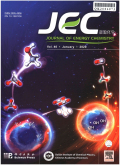- 钛学术文献服务平台 \
- 学术期刊 \
- 工业技术期刊 \
- 石油与天然气工业期刊 \
- 能源化学期刊 \
Electrochemical reactivity of In-Pb solid solution as a negative electrode for rechargeable Mg-ion batteries
Electrochemical reactivity of In-Pb solid solution as a negative electrode for rechargeable Mg-ion batteries
基本信息来源于合作网站,原文需代理用户跳转至来源网站获取
摘要:
A composite In-Pb:carbon was successfully synthetized by a two-step mechanochemical synthesis in order to obtain an adequate particles size and structure to investigate the electrochemical reactivity of the In-Pb solid solution towards Mg.A potential synergetic coupling of electroactive elements In and Pb was examined using electrochemical and ex situ X-ray diffraction analyses.The potential profile of the solid solution indicates the formation of Mg2Pb and MgIn.However,the diffraction study suggests a peculiar electrochemically-driven amorphization of MgIn during the magnesiation,in strong contrast to MgIn crystallization in In-based and InBi-based electrodes reported in the literature.Combining In and Pb favors the amorphization of MgIn and a high first magnesiation capacity of about 550 mAh g-1,but is thereafter detrimental to the material's reversibility.These results emphasize the possible influ-ence of electrochemically-driven amorphization and crystallization processes on electrochemical perfor-mance of battery materials.

推荐文章
Adsorption characteristics of copper ion on nanoporous silica
Nanoporous silica
Copper ion
Adsorption
Effects of a proline solution cover on the geochemical and mineralogical characteristics of high-sul
Proline
Coal gangue
Pollution control
Heavy metal fraction
Mineralogical characteristics
基于Solid Works的节能皮带抽油机
节能抽油机
Solid Works
三维建模
有限元分析
结构
B对铸造Pb-Mg-10Al合金摩擦磨损性能的影响
Pb-Mg-10Al合金
B
陶瓷相
摩擦磨损
摩擦因数
内容分析
关键词云
关键词热度
相关文献总数
(/次)
(/年)
引文网络
引文网络
二级参考文献 (0)
共引文献 (0)
参考文献 (1)
节点文献
引证文献 (0)
同被引文献 (0)
二级引证文献 (0)
2000(1)
- 参考文献(1)
- 二级参考文献(0)
2021(0)
- 参考文献(0)
- 二级参考文献(0)
- 引证文献(0)
- 二级引证文献(0)
引文网络交叉学科
相关学者/机构
期刊影响力
能源化学
主办单位:
中国科学院大连化学物理研究所
中国科学院成都有机化学研究所
出版周期:
双月刊
ISSN:
2095-4956
CN:
10-1287/O6
开本:
出版地:
大连市中山路457号
邮发代号:
创刊时间:
语种:
eng
出版文献量(篇)
2804
总下载数(次)
0
总被引数(次)
7996
期刊文献
相关文献
推荐文献
- 期刊分类
- 期刊(年)
- 期刊(期)
- 期刊推荐
一般工业技术
交通运输
军事科技
冶金工业
动力工程
化学工业
原子能技术
大学学报
建筑科学
无线电电子学与电信技术
机械与仪表工业
水利工程
环境科学与安全科学
电工技术
石油与天然气工业
矿业工程
自动化技术与计算机技术
航空航天
轻工业与手工业
金属学与金属工艺
能源化学2022
能源化学2021
能源化学2020
能源化学2019
能源化学2018
能源化学2017
能源化学2016
能源化学2015
能源化学2014
能源化学2013
能源化学2012
能源化学2011
能源化学2010
能源化学2009
能源化学2008
能源化学2007
能源化学2006
能源化学2005
能源化学2004
能源化学2003
能源化学2002
能源化学2001
能源化学2021年第9期
能源化学2021年第8期
能源化学2021年第7期
能源化学2021年第6期
能源化学2021年第5期
能源化学2021年第4期
能源化学2021年第3期
能源化学2021年第2期
能源化学2021年第12期
能源化学2021年第1期

 免费查重
免费查重










